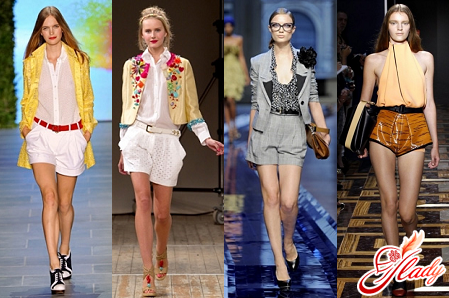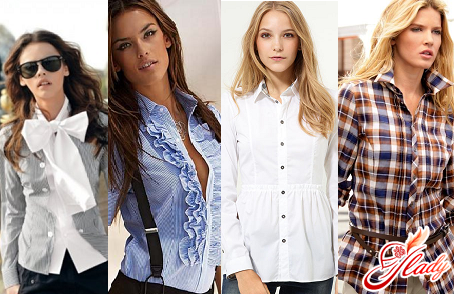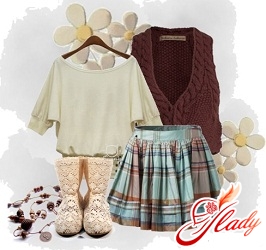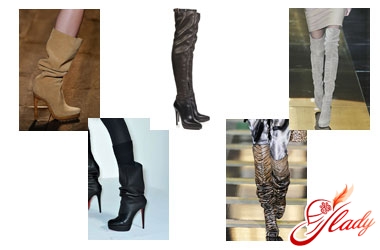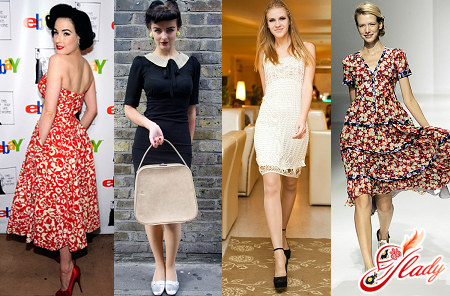 Some people call vintage style in clothingthings from grandma's chest, others attribute it to bohemian fashion. However, be that as it may, such an image is imbued with incredible elegance, restraint and grace. Initially, the very concept of "vintage" came to us from the lexicon of winemakers. It meant expensive, aged and high-quality wine. Over time, this word began to imply rarity, a certain exclusivity and the impossibility of counterfeiting. In the modern world, it has nothing to do with the skill of winemakers: today, vintage is outfits stylized as antique. They are worn not only at costume parties, but also in everyday life.
Some people call vintage style in clothingthings from grandma's chest, others attribute it to bohemian fashion. However, be that as it may, such an image is imbued with incredible elegance, restraint and grace. Initially, the very concept of "vintage" came to us from the lexicon of winemakers. It meant expensive, aged and high-quality wine. Over time, this word began to imply rarity, a certain exclusivity and the impossibility of counterfeiting. In the modern world, it has nothing to do with the skill of winemakers: today, vintage is outfits stylized as antique. They are worn not only at costume parties, but also in everyday life.
Vintage style: distinctive features
Let's talk about what vintage is and"What to eat it with", or rather, how to wear these things. Any girl can find outfits that represent this style in her grandmother's closet. After all, these are clothes that convey the spirit of a certain era - these can be skirts or dresses that were worn by fashionistas in the 20s, or blouses from the 50s. Such things are valued more and more every year, today even the most famous couturiers consider it their duty to release one or two collections designed "under the old days". Vintage in clothes is a time-tested style that bears the imprint of a particular period to which a certain thing belongs. This can be any wardrobe: authentic to the era of the 20s, representing decadence with languid feminine styles or free improvisation of the 30s, and, perhaps, military of the 40s. Bright T-shirts with prints, flared jeans in tandem with high platform boots, which were so popular with hippies of the seventies, will also do. In fact, vintage is clothing that was fashionable between the 1910s and 1980s, but left the world's catwalks no later than 20 years ago. Some more strict and picky stylists attribute to this style things that were in fashion in the mid-60s of the last century. In order not to get confused in the wording and clearly understand what vintage is, let's consider the main distinctive features that characterize this style:
- If you want to try on a vintage image, then bear in mind that the dress, skirt or blouse that you will get for this from the grandmother's trunk, should lie in it for at least twenty years.
- To clothes in the style of true vintage only design things are considered, and not blouses sewn at some unknown factory near Tula.
- Things that were made in the period from 1910 to 1960 represent vintage. And those that were created earlier, stylists are considered retro clothes.
A vintage wardrobe is more than just a setantique things, this is a real work of art. The most expensive, rare, and therefore so valuable are dresses made in the Victorian era. They are part of the cultural heritage and express the very essence of the past century - customs, interests, fashion trends and other features. It is not enough to just put on an old designer dress, because in order to create a truly vintage look, you need to master this special art. To do this, you need to not only select truly valuable things from a pile of things, but also be able to complement them with suitable accessories, shoes. In addition, in order for the clothes to look good, they will probably have to be taken in a little and adjusted to suit you. All wardrobe elements should be combined with each other and create a single harmonious look.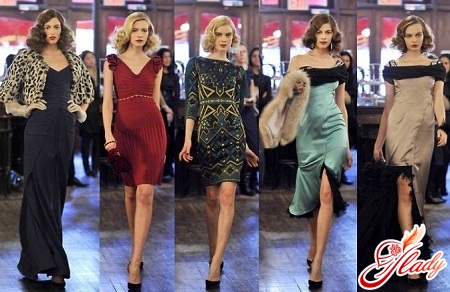
Vintage in different eras
If you want to create a wardrobe by choosingthis vintage style, you should be guided by fashion trends, because each era has its own characteristics. Thus, the 20s are characterized by freedom of morals and rebellion. At that time, many girls put on the mask of a crazy teenager - they did short haircuts, dyed their hair in the most incredible colors, wore shapeless dresses and danced all night long to the sounds of jazz. An invariable attribute of the image was bright provocative makeup and a cigarette on a long mouthpiece. The main distinguishing features in the clothes of that time were:
- asymmetrical cut;
- low waistline;
- emphasis on free, sometimes even formless models - so, for example, in the course there was a coat with a smell;
- length of dresses and skirts to the middle of the roe;
- feathers, fringe, net, sequins as the main attributes of the evening image.
The ideal figure for many women has become"inverted quadrilateral" with narrow hips and prominent shoulders, which ladies tried their best to match. This was naturally reflected in clothing models. At that time, it was considered bad manners to expose the forehead, so many girls wore hats (the "bell" hat was especially popular), long thick bangs and headbands covering the upper part of the face. The style icons of that era are Greta Garbo, Lou Brooks, and Josephine Baker. The era of rebellion and defiantly free morals did not last long - it was replaced by femininity and elegance again. In the 30s, many women became more independent, went to work. Therefore, there was a clear division of clothing into evening and casual. The former was distinguished by luxurious fabrics shimmering with metal with an abundance of jewelry and bright fittings. Things for going to the office had to be practical and not easily soiled. Chiffon, crepe, satin, as well as silk and viscose came into fashion. As for styles, designers of that time preferred models cut at an angle of 45 degrees. As a result, dresses that tied around the neck, tops, and collars-yoke appeared. To create additional volume, drapery, pleated inserts and expanding folds were used. Dresses and skirts were sewn, slightly lengthened at the back and shortened at the front. Bright representatives of the 30s style are Vivien Leigh, Dorothy Dandridge and Betty Davis. In the post-war period, there was not only no strength, but also no opportunity to think about fashion. Therefore, the main requirements for clothing were practicality, resistance to stains and comfort. Women began to wear tapered trousers, jeans and sweaters. In some countries, special laws were even developed limiting designers in their desire for creativity. However, ladies tired of the dullness, difficulties, and hard everyday life wanted to feel like true ladies again. The great Christian Dior's collection called "New Look", released in 1947, is rightfully considered the revival of elegance and sophistication. The designer sent models on the catwalk in fitted jackets thrown over lace underwear, in calf-length skirts, with silk scarves elegantly wrapped around the neck. Considering the shortage that reigned at that time, such an abundance of fabrics and new-fangled styles created a real sensation. Among the celebrities who were distinguished by exquisite taste and were style icons were Marlene Dietrich, Rita Hayworth, and Catherine Hepburn.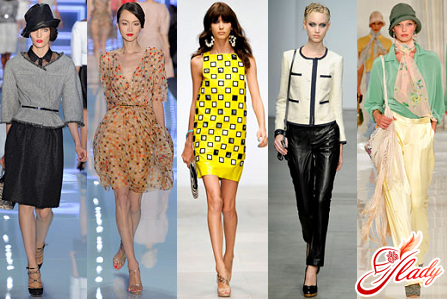
Vintage image: how to avoid mistakes
Vintage is the style of years gone by, imbued withelegance and grace. It should not be confused with second-hand clothes. If you want to create such an image, then the first place you should go is a flea market. However, this is not just shopping - it is a whole excursion into the past. Here you can find breeches that Marlene Dietrich loved to wear, vintage jackets, exquisite dresses. Owners of antique shops collect vintage treasures from all over the world: rings with large stones, original brooches, unimaginably beautiful earrings. Naturally, all these rare and exclusive things will cost a lot. Therefore, if you do not have such an opportunity, rummage through your grandmother's wardrobe, perhaps you will find something suitable. Experts divide a vintage wardrobe into several groups. So, if there are no signs of wear on clothes or accessories, they are called Mint, and where minor wear is visible - Near Mint. Next come the examples that their previous owners used irregularly - Excellent, with small but visible defects - Very Good, and those whose original appearance can no longer be restored are classified as Good. There is also a division of this style by its types, namely:
- Genuine vintage - clothes made by these designers no later than the 1980s.
- Neovintage - things made by artificial way. This effect is achieved through the use of special fabrics and modern technologies.
- Combined vintage is clothing that is sewn using both modern materials and authentic elements of that time.
- The design of the vintage style includes silhouettes, cut, decor, as well as the motives and ideas inherent in that era.
So if you want to create a vintage look,you should consider these categories when choosing things. By the way, in this case it will be quite difficult to decide on the sizes, especially if you buy clothes online. And all because vintage models often do not contain labels, and the size system adopted in those years does not coincide with the current one. When creating a wardrobe, study the fashion trends and movements of the 20th century - this way you can decide which image to choose, the rebellious 20s or the feminine 30s. Vintage style suits almost everyone, especially artistic and creative people. However, wearing such things correctly is a whole art. To master it, consider the following:
- If your wardrobe from head to foot consists of rare and rare clothes and accessories, it's fine, but all the elements of the ensemble must relate to the same time interval.
- Combine the authentic vintage style with the neo-vintagethings can be done, but it should be done very carefully. Do not mix the old models with cheap decorations and futuristic style - it will look tasteless and even vulgar.
- The main thing is not to become a hostage to the past. Do not get hung up on one current, watch out for the latest innovations in the fashion world, experiment and look for yourself.
The hallmark of vintage clothing isexclusivity, so you should not blindly imitate the style icons of certain years. Be yourself, show your individuality and character through the prism of vintage and elegant things. We recommend reading:




